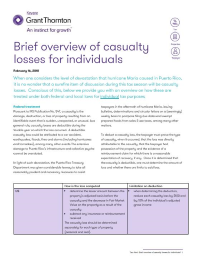When one considers the level of devastation that hurricane Maria caused in Puerto Rico, it is no wonder that a surefire item of discussion during this tax season will be casualty losses. Conscious of this, below we provide you with an overview on how these are treated under both federal and local laws for individual tax purposes.
Federal treatment
Pursuant to IRS Publication No. 547, a casualty is the damage, destruction, or loss of property resulting from an identifiable event that is sudden, unexpected, or unusual. As a general rule, casualty losses are deductible during the taxable year on which the loss occurred. A deductible casualty loss could be attributed to a car accident, earthquakes, floods, fires and storms (including hurricanes and tornadoes), among many other events. The extensive damage to Puerto Rico’s infrastructure and collective psyche cannot be overstated.
In light of such devastation, the Puerto Rico Treasury Department was given considerable leeway to take all reasonably prudent and necessary measures to assist taxpayers in the aftermath of hurricane Maria, issuing bulletins, determinations and circular letters on a (seemingly) weekly basis to postpone filing due dates and exempt prepared foods from sales & use taxes, among many other matters.
To deduct a casualty loss, the taxpayer must prove the type of casualty, when it occurred, that the loss was directly attributable to the casualty, that the taxpayer had possession of the property and the existence of a reimbursement claim for which there is a reasonable expectation of recovery, if any. Once it is determined that the casualty is deductible, one must determine the amount of loss and whether there are limits to said loss.
| How is the loss computed | Limitation on deduction | |
| US |
The casualty loss should be determined separately for each type of property (personal and real). |
|
How about Puerto Rico?
For Puerto Rico purposes, the individual taxpayer the applicable tax treatment will depend on whether the property that suffered the loss is the principal place of residence or personal property.
| How is the loss computed | Limitation on deduction | |
| Residential property |
|
|
|
Personal property (i.e. automobiles, furniture, household goods and other property, excluding the value of jewelry or cash) |
|
|


